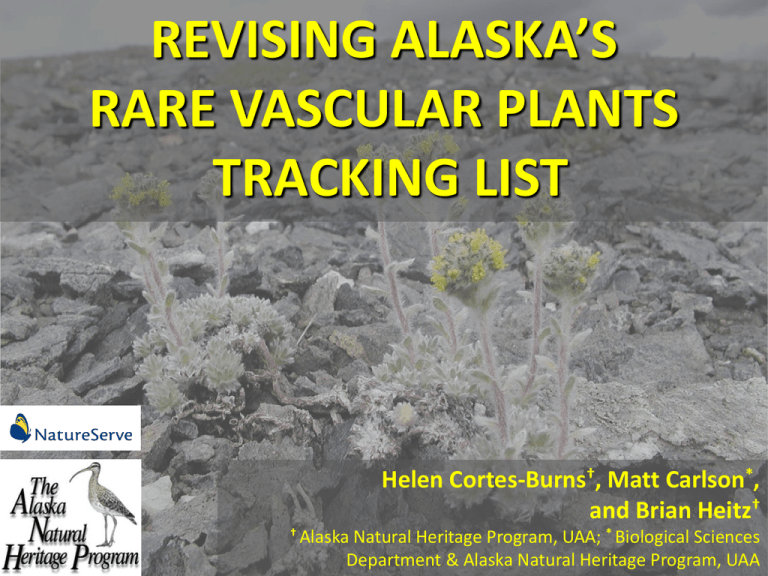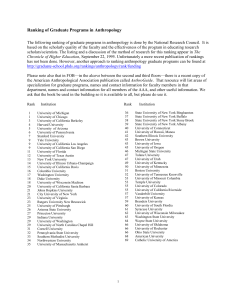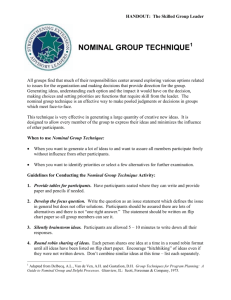Carlson_Cortes-Burns_AKNHP
advertisement

REVISING ALASKA’S RARE VASCULAR PLANTS TRACKING LIST Helen Cortes-Burns†, Matt Carlson*, and Brian Heitz† † Alaska Natural Heritage Program, UAA; * Biological Sciences Department & Alaska Natural Heritage Program, UAA NatureServe’s Ranking Methodology Mertensia drummondii © Jo Overholdt ??? S2 G2 AKNHP Ranking Process: Overview Field data, USFS, NPSpecies, Arctos … Data compilation ✔ Taxonomic revisions ✔ Expert input Spatially explicit database (GIS) ✔ Expert input Rank Calculator Conservation Ranks NatureServe review and changes BIOTICS (statewide rare species’ database) Data requests status reports Rare Plant Field Guide NatureServe’s Ranking Methodology • Non-profit conservation organization • Provides scientific basis for effective conservation action • International network of partners • Heritage Programs & Data Conservation Centers • 50 U.S. states, Canada, Latin America and the Caribbean NatureServe’s Ranking Methodology Objectives • • • Transparency Repeatability Consistency among and between groups, and across borders NatureServe’s Rank Calculator • • Ranking ‘themes’ (3) Rarity – Trends - Threats Ranking factors (10) Help identify specific information gaps -- to direct efforts to increase our knowledge of the species and its status assessment NatureServe’s Ranking Methodology Weighted factors and categories • Premise: “Rarity is the most important, but not sole, influence on extinction probability” • The weights assigned to factors reflect perceived influence on extinction risk • RARITY > TRENDS > THREATS • • • • Population size Area of occupancy % occupancy area with ecological integrity Short term trends Rarity NatureServe’s Ranking Methodology Category Factor Range Extent [disjunct taxa – multiple smaller ranges] Area of Occupancy RARITY -area within the range that is actually occupied Population Size -Estimated wild population for the entire range # occurrences [# Elements of Occurrence (1km)] # occurrences or % area with good ecological Factor Type Weight Condition Core 1.0 Always use, if available. Core 2.0 Always use, if available. Core 2.0 Always use, if available. Core 1.0 Always use, if available. Core 2.0 Always use, if available. 1.0 Only if # occurrences AND area of occp. UNKNOWN integrity Habitat specificity Conditional NatureServe’s Ranking Methodology TRENDS Factor Category Factor Factor Type Weight Condition Long term Core 1.0 Always use, if available. Core 2.0 Always use, if available. Core 1.0 Always use, if available. 1.0 Only use if Threat Impact is Unknown or Null. Past 200 yrs Short term (10-100 years) THREATS Threat impact (current threats due to anthropogenic actions – none if all occurrences are under protection) Intrinsic vulnerability Degree to which intrinsic characteristics make it susceptible to natural or anthropogenic stresses Conditional The Ranking Process Rank Calculator Form Change to return GRanks, NRanks, or S Sranks: change using dropdown; also affects Calculator Table Species or Ecosystem Scientific Name Ambrosia chamissonis Type (enter "infraspecies" for a T-Rank) Species Optional Information: Element ID global, national, or subnational Elcode Common Name Classification Vascular Plant COMMENTS (Place cursor in cell to see full text.) The Ranking Process Range Extent D 2 Area of Occupancy: C X Rarity2 Rarity weight: 0.5 Rarity1 1 D = 1,000-5,000 sq km (~400-2,000 c. 2,000 sq km, restricted to sq mi) coastal areas in SE AK FILL OUT ONLY 1 OF FOLLOWING 3 FIELDS Direct estimate (ecosystems) OR 2 4 km grid cells (species) OR 2 1 km grid cells (linear species) C C = 3-5 4-km2 grid cells the 3 records from AK are distributed in clusters that would occupy 3 distinct 4 sq km cells 1 Number of Occurrences A A=1-5 3 distinct Eos 2 Population Size AC AC = 1 - 1000 individuals “rare”, “forming 1-2 sq m patches where found” 2 Good Viability/Ecological Integrity: B FILL OUT ONLY 1 OF FOLLOWING 2 FIELDS B Number of Occurrences OR B F Percent Area F 1 Environmental Specificity (opt.) B B = Very few (1-3) occurrences with excellent or good viability or ecological integrity F = Excellent percentage (>40%) of area with excellent or good viability or ecological integrity B = Narrow. Specialist or community coastal beaches (sand, with key requirements common beach meadows, by logs) 0.3 Trend/Threat 2 Short-term Trend U U = Unknown 1 Long-term Trend U U = Unknown 1 Threat Impact U U = Unknown mainly on/near USFS managed coastal beaches … BC = Moderately vulnerable to not intrinsically vulnerable Restricted range and habitat somewhat vulnerable to major catastrophes X 0.2 Threats Trends The Ranking Process 1 Intrinsic Vulnerability (opt.) BC The Ranking Process Calculated Rank S2? Always review the calculated rank. Assigned Rank* S1S2 Adjusted Rank Rank Adjustment Reasons Assigned Rank Reasons Rank Author Rank Date Rank Calculator Internal Notes The rank oscillates from S1 to S2 when one manipulates the factorvalues slightly (e.g. vulnerability and pop size) compromise on S1S2. Same as 2008 rank. Cortes-Burns, Helen 27-Apr-2011 Enter Ctrl ; for today's date. Cochlearia sessilifolia @ Stacy Studebaker Changes to date Papaver maccounii Artemisia senjavinensis Papaver gorodkovii @ Rob Lipkin Notable deletions to date 2008 scientific name 2008 S, G ranks new scientific name Arnica lessingii ssp. norbergii S2 G5T2Q Arnica lessingii Artemisia tilesii ssp. unalaschcensis S3 G5T3Q Artemisia tilesii ssp. tilesii Draba kananaskis S1 G1Q Draba juvenilis Betula papyrifera var. commutata S2 G5T5 environmental variant Ranking of additional taxa Scientific name • Eritrichium chamissonis ? • Tanacetum bipinnatum ssp. bipinnatum ? • Bidens tripartita? Others? Taxonomic changes to date 2008 scientific name Arabis calderi Arabis codyi Draba lonchocarpa var. vestita 2008 S, G ranks S2 G3G4 S1 G5 S2? G5T3 2011 scientific name Boechera calderi Boechera lemmonii D. lonchocarpa might be incorporated into D. nivalis 2011 S rank Not reviewed S1S2* Not reviewed Draba paysonii SR G5 D. novolympica SR Thlaspi arcticum S3 G3 Noccaea arctica Not reviewed Agoseris aurantiaca S1 G5 A. aurantiaca var. aurantiaca Agoseris glauca S2 G5 A. glauca var. dasycephala S3* Cirsium edule S1 G4 C. edule var. macounii S2* Stellaria dicranoides S3 G3 Cherleria dicranoides * (2011) Ranks obtained using the Rank Calculator; pending expert input SR Species reported but without persuasive documentation S1S2* Not reviewed Next steps 1. Finish gathering population location data input needed! 2. Delimit records as ‘Elements of Occurrence’ (NatureServe’s conservation unit). 3. Calculate ranks for all 2008 tracked species [April - May 2011] 4. Receive input on new ranks from experts input needed! 5. Compile information Re-assess ranks 6. Produce a final list of tracked species and ranks [Fall 2011] Future directions • Upload all records into BIOTICS • Serve “fuzzed” rare plant data online http://aknhp.uaa.alaska.edu/maps/biotics.php • Update the Rare Plant Field Guide [ongoing] - 70 rare vascular plant taxa - Project funded by the BLM • Develop and implement an ‘Annual Data Exchange System’ - Similar to AKEPIC, records would be received, quality controlled, and uploaded within a year of receipt • …. Eco-regional ranks? Ranking of additional taxa Acknowledgements Special thanks to Dave Murray (UAF), Rob Lipkin (Lazy Mountain Biological Consulting), Carolyn Parker (UAM), and Bruce Bennett (Environment Yukon) for providing invaluable taxonomic advice Funding support: the Bureau of Land Management, Alaska and the Alaska Natural Heritage Program, UAA We are grateful to the many people that contribute information on Alaska’s rare plant populations, among others: • UAM - ARCTOS • Carolyn Parker, UAM • Mary Stensvold, USFS • Brad Krieckhaus, USFS • Mike Duffy • Stacy Studebaker, Kodiak NWR Artemisia globularia var. lutea




